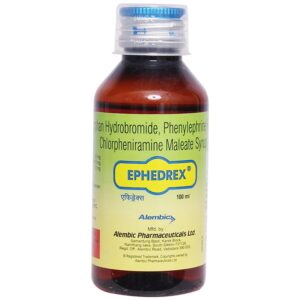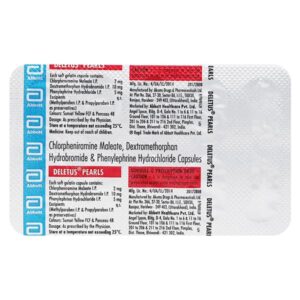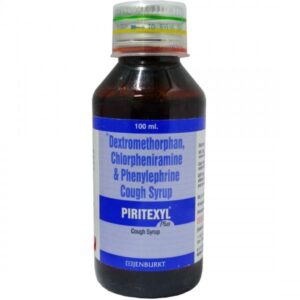CHLORPHENIRAMINE + DEXTROMETHORPHAN + PHENYLEPHRINE
Chlorpheniramine: Chlorpheniramine is an antihistamine drug that is commonly used to treat allergy symptoms such as sneezing, itching, watery eyes, and runny nose. It belongs to the class of drugs known as first-generation antihistamines.
Chlorpheniramine works by blocking the effects of histamine, a substance produced by the body during an allergic reaction. By doing so, it helps to relieve symptoms caused by the release of histamine, such as nasal congestion and itching.
The usual adult dose of chlorpheniramine for allergies is 4 mg every 4 to 6 hours, not exceeding 24 mg in a 24-hour period. For children aged 6 to 12 years, the recommended dose is 2 mg every 4 to 6 hours, not exceeding 12 mg in a 24-hour period. However, it is important to follow the dosage instructions provided by your healthcare provider, as they may vary based on the individual’s age, weight, and condition.
Common side effects of chlorpheniramine may include drowsiness, dizziness, dry mouth, blurred vision, constipation, and urinary retention. These side effects are more common with higher doses. Some individuals may also experience an upset stomach or difficulty sleeping. It is important to avoid driving or engaging in activities that require alertness until you know how this medication affects you.
Chlorpheniramine may interact with other medications, such as sedatives, tranquilizers, and certain antidepressants, so it is important to inform your healthcare provider about all the medications you are taking.
Overall, Chlorpheniramine is an effective medication for the relief of allergy symptoms. However, it is always recommended to consult with a healthcare professional before starting or changing any medications.
Dextromethorphan: Dextromethorphan is a commonly used over-the-counter cough suppressant medication. It is part of the class of drugs known as antitussives, which are used to relieve coughing.
The exact mechanism of action of dextromethorphan is not fully understood. However, it is believed to work by acting on the brain’s cough center, specifically the medullary cough center, to suppress the urge to cough. It does not treat the underlying cause of the cough but rather provides temporary relief by reducing the frequency and severity of coughing.
Dextromethorphan is typically available in various forms such as syrups, capsules, and lozenges. The dose and frequency of use depend on the specific formulation and the individual’s age and medical condition. It is important to carefully follow the instructions provided by the manufacturer or healthcare provider.
Like any medication, dextromethorphan can have side effects. Common side effects may include drowsiness, dizziness, nausea, and dry mouth. Rare but potentially serious side effects include allergic reactions, difficulty breathing, confusion, hallucinations, and rapid heartbeat. It is recommended to seek medical attention if any severe or concerning side effects occur.
Dextromethorphan can interact with certain medications, so it’s important to inform your healthcare provider about any other medications you are taking before using it. Additionally, it should be used with caution in individuals with certain medical conditions, such as lung disease or liver impairment.
It is crucial to use dextromethorphan as directed and not exceed the recommended dose. Taking excessive amounts of dextromethorphan can lead to a condition called dextromethorphan abuse or “robotripping,” which can cause hallucinations, disorientation, and other harmful effects.
As with any medication, it is recommended to consult with a healthcare professional before using dextromethorphan, especially if you have any underlying medical conditions or are currently taking other medications.
Phenylephrine: Phenylephrine is a medication primarily used as a decongestant to relieve nasal congestion caused by allergies, colds, or sinusitis. It can also be used as a mydriatic agent to dilate the pupil during eye exams and as a vasopressor to increase blood pressure in certain medical situations.
The mechanism of action of Phenylephrine involves stimulating alpha-adrenergic receptors, leading to vasoconstriction and reducing swelling in the nasal passages. This helps to relieve congestion and improve breathing.
The dosage of Phenylephrine depends on the specific form of the medication. For nasal congestion, it is commonly available as nasal sprays or drops, with recommended doses typically ranging from 2-3 sprays or drops in each nostril every 4-6 hours. For eye exams, it may be administered as eye drops with a typical dose of 2-3 drops in each eye.
While Phenylephrine is generally safe, it may cause some side effects. Common side effects include increased heart rate, elevated blood pressure, headache, nausea, dizziness, tremors, sleep disturbances, and anxiety. Some individuals may also experience allergic reactions such as rash, itching, swelling, or difficulty breathing. It is important to follow the recommended dosage and consult a healthcare professional if any concerning side effects occur. Additionally, Phenylephrine should not be used by individuals with certain medical conditions such as high blood pressure, heart disease, or thyroid problems, without consulting a doctor.





